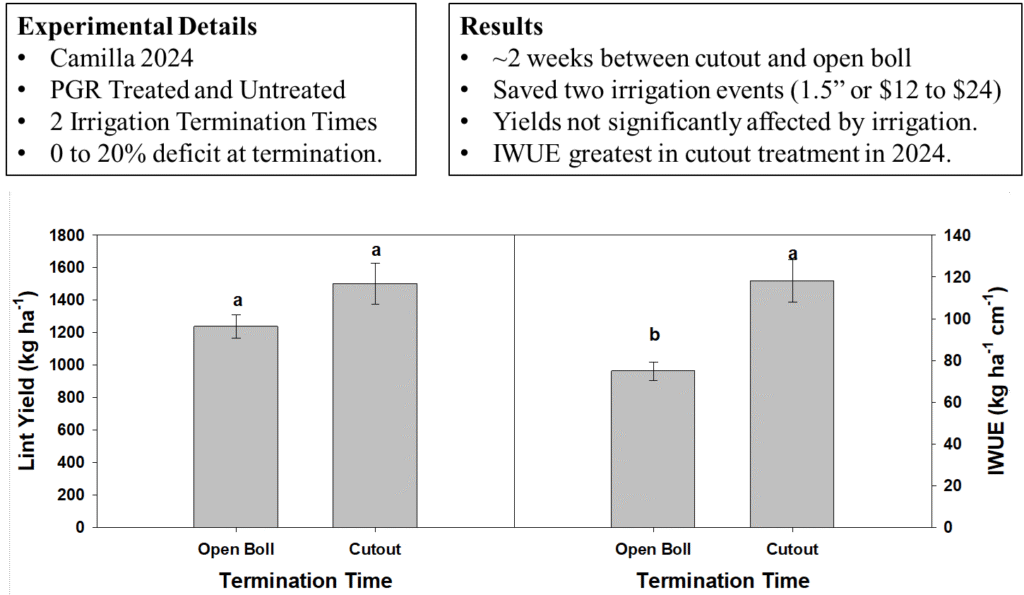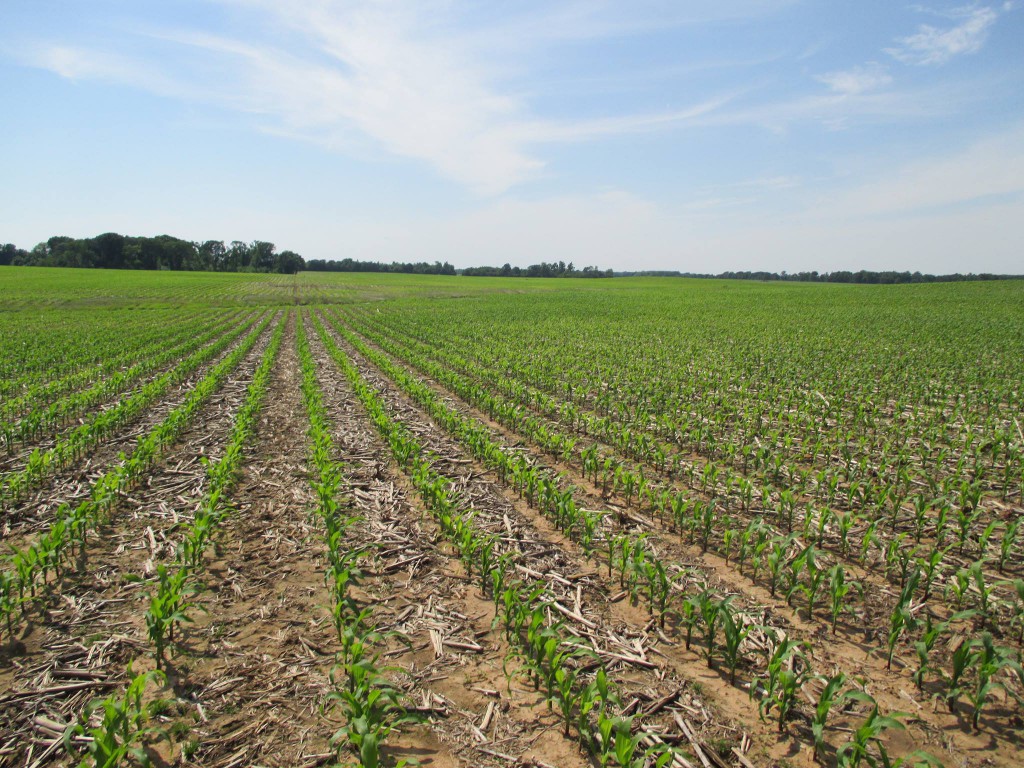By: Wesley Porter, John L. Snider, Jayson Wisekal, and Sarah Beth Thompson
The weather as usual is very unpredictable. We go from hot and dry to hot and humid, to cool and wet and back to hot and dry. Then, during the fall we always have the potential for tropical storms and hurricanes. While, in some cases they can bring much needed moisture to our crops, in other cases they can bring damage and flooding.
As we are moving into and through the peak water use period and are moving to the end of the season, we need to consider how to appropriately match water requirements of the cotton crop to our irrigation applications. We have been through all of the aforementioned weather conditions over the month of July moving into August and it will be hard to predict where we will be in the next few weeks.
Understanding Cotton’s Water Demands
Cotton’s peak water use occurs during peak bloom, typically between weeks 10–13 after planting and weeks 4 to 6 of bloom (or 65–90 days after planting). During this time, the crop can require up to 1.5 inches of water per week.

As we look at the tradeoff of continuing irrigation towards the end of the season we have to evaluate the cost of irrigation applications and the return on investment of those applications. Currently, based on the UGA Enterprise Budgets which can be found at https://agecon.uga.edu/extension/budgets.html, the estimated cost of irrigation applications are shown below.
Irrigation costs by energy source:
Electric: ~$8 per acre-inch
Diesel: ~$16 per acre-inch
Seed Cotton Value by Position on the Plant
Next, we have to determine the value of the harvestable bolls on our cotton plant. The “Cotton Money Tree” figure below shows the results of a three site, hand harvested, and box mapped cotton fiber quality value map. What should be inferred from both the table and the “Cotton Money Tree” is that the majority of the value of our seed cotton value comes from the lower third of the plant. However, in some cases we see the top quarter of the plant when we are scouting the field and want to finish the upper most bolls out, when we should be focused on the bottom portion of the plant. When cotton bolls are lost on plants, it is typically the older most mature bolls or as shown in this graphic the highest value bolls. These are the bolls that are most susceptible to boll rot and hard lock too.

| Fruiting Location | Value |
| 1st Positions | 72% |
| 2nd Positions | 18% |
| 3rd Positions | 5% |
| Vegetative | 5% |
| Node Location | |
| Nodes ≤10 | 60% |
| Nodes 11-15 | 31% |
| Nodes ≥ 16 | 9% |
Data collected by Whitaker et al. 2019, from three locations across the state of GA.
When to Terminate Irrigation
The official UGA recommendation (2024 Georgia Cotton Production Guide | UGA Cooperative Extension) for irrigation termination is to terminate irrigation at 10% open boll—typically when 1–3 bolls are visibly cracked. Continuing irrigation beyond this point can lead to:
- Boll rot
- Hard lock
- Increased unnecessary leaf wetness periods
- Increased disease pressure due to fall humidity and rainfall
Before Deciding to Terminate Irrigation:
- Scout the field and check the current cotton physiological stage and track accordingly, when the stage has reached physiological cutout or 3 nodes above white flower, decisions about irrigation termination should start to be considered.
- Check soil moisture in the field and make an estimation on current status and how long it will be until the crop reaches 10% open boll. The profile needs to be full at 10% open boll to finish off for the season.
- Consider near-term weather forecasts .
- Do your best to reduce the leaf wetness period, nighttime dew will already puts moisture on the leaves, if possible, do not continue to stretch this period with irrigation. In most cases, this is not possible due to irrigation application constraints.
- If moisture is determined to be present and adequate or rain is expected and guaranteed, irrigation can be safely terminated.
Recent Cotton Irrigation Termination Research in Georgia

In a two-year study by Lawson et al. 2023, four irrigation termination dates were evaluated, which were Cutout, Open Boll, Open Boll + 2 Weeks (OB+2), and Open Boll + 4 Weeks (OB+4). Overall, as shown in the graphs above, there were significant difference between years for yield, but not for yield within each year. However, there were significant differences for Irrigation Water Use Efficiency (IWUE). This is very important, because it shows that there was no effect, positive or negative, for continued irrigation after cutout, but there were savings in irrigation water.
The table below shows the result of the study from the economic perspective. I used the previously mentioned irrigation cost data to calculate the cost of additional irrigation applications at the end of the season. Remember, there were not significant differences in yield, so I did not consider lint yield profit differences in this calculation, only irrigation.
During 2021, there was sufficient rainfall, such that only one additional irrigation application of 0.4 inches applied to the OB+4 Weeks treatment. As shown, this additional irrigation cost $3.20 and $6.40 per acre respectively. However, during 2022, the fall was much drier, and each treatment required additional irrigation. As shown in the table, the OB treatment costs an additional $26.40 and $52.80 for electric and diesel respectively and the additional cost only went up from there for irrigating beyond cutout.

An additional study was started during 2024 to determine effects of terminating irrigation at open boll and at cutout. 2024 was the first year of this study and data for 2025 are not yet available. Similar to the previous study there were no significant differences between the two irrigation termination treatments, but there were significant differences in the IWUE’s. During 2024 $12 to $24 dollars per acre were saved for the two irrigation events that were not applied to the cutout treatment.

Thus, while we do not have enough site years of data to make a hard recommendation to terminate irrigation at the cutout time, frame data are showing that if adequate moisture is available during this stage, there are no yield penalties for terminating irrigation and there is no yield gained for irrigating beyond this point.
With this stated, I strongly encourage growers to consider terminating irrigation no later than 10% open boll and earlier if they have adequate soil moisture and are confident in their current situation.
Irrigation termination in cotton can be a tricky and potentially costly decision. I urge you to scout your fields, monitor soil moisture, plant physiological stage, weather predictions and conditions, and make a final decision when best fits your field and situation. For support on these decisions feel free to reach out to your local UGA County Extension Agent.
